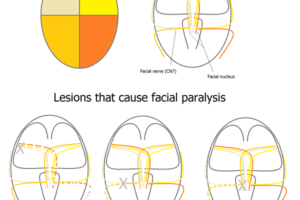The TRN sits like a shield covering the ventral surface the thalamus and projects locally to the other nuclei of the thalamus.
The TRN receives input from both the cortex and brainstem that are thought to control states of consciousness. Because the TRN has exclusively inhibitory outputs (GABA) onto the dorsal thalamic nuclei, it is thought to “gate” information through the thalamus.
When inactive the TRN has no effect on the relay of information through the thalamus – sensory inputs come in from the periphery and are faithfully transmitted to cortex. When active, however, the TRN inhibits thalamic relay nuclei and sensory information does not get relayed to cortex. This is thought to account for our relative insensitivity to sounds and light when we are asleep. Brainstem and cortical activity during sleep specifically activates the TRN, shutting down relay of information to the cortex.
Of course, loud sounds will startle us out of sleep so there must be a mechanism to let strong stimuli get through to cortex and “wake us up.” This is thought to happen through the inactivation and de-inactivation of a specific ion channel in thalamic relay cells. When the TRN is silent, thalamic relay cells are regular activated (depolarized) by input. This near-constant depolarization inactivates a T-type calcium channel. When the TRN is active, the relay cells are more hyperpolarized, so the T-type calcium channel is de-inactivated. When a big enough depolarization comes into a relay cell (that is, when a big stimulus like a loud sound comes in) the relay cell depolarizes and activates the T-type calcium channels. Once the T-type channels activate, they cause the relay cell to fire a large burst of action potentials – sending a powerful signal on to sensory cortex.
>So the activity level of the TRN determines whether the thalamus is in “tonic mode” in which sensory stimuli are normally transmitted to the cortex (“wakefulness”) or in “burst mode” in which sensory stimuli don’t get to the cortex (“sleep”) unless the stimulus is very strong and a burst of action potentials “wakes up” the cortex.

